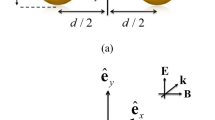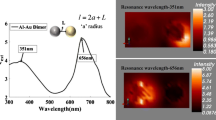Abstract
The linear optical properties and the surface-enhanced Raman scattering (SERS) effect of spherical palladium nanoparticle dimers are analyzed theoretically using generalized Mie theory. The calculation results demonstrate that the near-field coupling effect greatly influences the absorption, scattering and extinction spectra of nanoparticle dimers. The surface plasmon resonance wavelength red-shifts dramatically as the separation between nanoparticles decreases. Because of the near-field coupling between nanoparticles and the size effect, the maximum SERS enhancement factor at the’ hot spot’ between palladium nanoparticle dimers is as high as 107–108, while the averaged SERS enhancement factor over the entire nanoparticle surface is in the range of 105–106. The deviation between the position of the peak in the extinction spectrum and the wavelength for maximum surface-averaged enhancement for the Pd nanoparticle dimers indicates that localized surface plasmon resonance has different influences on the far and near fields. These theoretical results may help to reveal the relationship between the far and near fields, as well as understand the mechanism of electromagnetic enhancement in the surface-enhanced scattering of transition metals.
Similar content being viewed by others
References
Sonnichsen C, Alivisatos A P. Gold nanorods as novel nonbleaching plasmon-based orientation sensors for polarized single-particle microscopy. Nano Lett, 2005, 5: 301–304
Tian Z Q, Ren B, Li J F, et al. Expanding generality of surface- enhanced Raman spectroscopy with borrowing SERS activity strategy. Chem Commum, 2007, 34: 3514–3534
Huang X, El-Sayed I H, Qian W, et al. Cancer cell imaging and photothermal therapy in the near-infrared region by using gold nanorods. J Am Chem Soc, 2006, 128: 2115–2120
Ferry V E, Sweatlock L A, Pacifici D, et al. Plasmonic nanostructure design for efficient light coupling into solar cells. Nano Lett, 2008, 8: 4391–4397
Sukharev M, Seideman T. Phase and polarization control as a route to plasmonic nanodevices. Nano Lett, 2006, 6: 715–719
Tian Z Q, Ren B, Mao B W. Extending surface Raman spectroscopy to transition metal surfaces for practical applications 1. Vibrational properties of thiocyanate and carbon monoxide adsorbed on electrochemically activated platinum surfaces. J Phys Chem B, 1997, 101: 1338–1346
Ren B, Lin X F, Yang Z L, et al. Surface-enhanced Raman scattering in the ultraviolet spectral region: UV-SERS on rhodium and ruthenium electrodes. J Am Chem Soc, 2003, 125: 9598–9599
Wu D Y, Li J F, Ren B, et al. Electrochemical surface-enhanced Raman spectroscopy of nanostructures. Chem Soc Rev, 2008, 37: 1025–1041
Li J F, Yang Z L, Ren B, et al. Surface-enhanced Raman spectroscopy using gold-core platinum-shell nanoparticle film electrodes: Toward a versatile vibrational strategy for electrochemical interfaces. Langmuir, 2006, 22: 10372–10379
Fan F R, Liu D Y, Wu Y F, et al. Epitaxial growth of heterogeneous metal nanocrystals: From gold nano-octahedra to palladium and silver nanocubes. J Am Chem Soc, 2008, 130: 6949–6951
Tian Z Q, Ren B. Adsorption and reaction at electrochemical interfaces as probed by surface-enhanced Raman spectroscopy. Annu Rev Phys Chem, 2004, 55: 197–299
Liu Z, Yang Z L, Cui L, et al. Electrochemically roughened palladium electrodes for surface-enhanced Raman spectroscopy: Methodology, mechanism and application. J Phys Chem C, 2007, 111: 1770–1775
Cui L, Wang A, Wu D Y, et al. Shaping and shelling Pt and Pd nanoparticles for ultraviolet laser excited surface-enhanced Raman scattering. J Phys Chem C, 2008, 112: 17618–17624
Ren B, Liu G K, Lian X B, et al. Raman spectroscopy on transition metals. Anal Bioanal Chem, 2007, 388: 29–45
Yang Z L, Wu D Y, Yao J L, et al. SERS mechanism of nickel electrode. Chinese Sci Bull, 2002, 47: 1983–1986
Xiong Y, McLellan J M, Chen J, et al. Kinetically controlled synthesis of triangular and hexagonal nanoplates of palladium and their SPR/SERS properties. J Am Chem Soc, 2005, 127: 17118–17127
Yang Z L, Li Y, Li Z P, et al. Surface enhanced Raman scattering of pyridine adsorbed on Au@Pd core/shell nanoparticles. J Chem Phys, 2009, 130: 234705
Xu H X, Bjerneld E J, Kall M, et al. Spectroscopy of single hemoglobin molecules by surface enhanced Raman scattering. Phys Rev Lett, 1999, 83: 4357–4360
Xu H X, Aizpurua J, Kall M, et al. Electromagnetic contributions to single-molecule sensitivity in surface-enhanced Raman scattering. Phys Rev E, 2000, 62: 4318–4324
Moskovits M, Tay L L, Yang J, et al. SERS and the single molecule. Topics Appl Phys, 2002, 82: 215–227
Kneipp K, Kneipp H, Bohr H G. Single-molecule SERS spectroscopy. Topics Appl Phys, 2006, 103: 261–278
Peterson B, Strom S. T matrix for electromagnetic scattering from an arbitrary number of scatterers and representations of E(3). Phys Rev D, 1973, 8: 3361–3677
Mackowski D W, Mishchenko M I. Calculation of the T matrix and the scattering matrix for ensembles of spheres. J Opt Soc Am A, 1996, 13: 2266–2278
Brown R J C, Wang J, Milton M J T. Electromagnetic modeling of Raman enhancement from nanoscale structures as means to predict the efficacy of SERS substrates. J Nanomater, 2007, 1: 12086
Purcell E M, Pennypacker C R. Scattering and absorption of light by nanospherical dielectric grains. Astrophys J, 1973, 186: 705–714
Flatau P J, Fuller K A, Mackowski D W. Scattering by two spheres in contact: Comparisons between discrete-dipole approximation and modal analysis. Appl Opt, 1993, 32: 3302–3305
Yang Z L, Aizpurua J, Xu H X. Electromagnetic field enhancement in TERS configurations. J Raman Spectrosc, 2009, 40: 1343–1348
Taflove A. Computational Electrodynamics: The Finite-Difference Time-Domain Method. Boston, MA: Artech House, 1995
Novotny L, Bian R X, Xie X S. Theory of nanometric optical tweezers. Phys Rev Lett, 1997, 79: 645–648
Videen G, Sun W, Fu Q. Light scattering from irregular tetrahedral aggregates. Opt Commum, 1998, 156: 5–9
Ozbay E. Plasmonics: Merging photonics and electronics at nanoscale dimensions. Science, 2006, 331: 189–193
Mie G. Beitrage zur optik truber medien seziell kolloidaler matallosungen. Ann Phys, 1908, 25: 377–455
Xu H X, Kall M. Surface-plasmon-enhanced optical forces in silver nanoaggregates. Phys Rev Lett, 2002, 89: 246802
Comberg U, Wriedt T. Comparison of scattering calculations for aggregated particles based on different models. J Quant Spectrosc Radiat Transfer, 1999, 63: 149–162
Xu H X. A new method by extending Mie theory to calculate local field in outside/inside of aggregates of arbitrary spheres. Phys Lett A, 2003, 312: 411–419
Xu H X. Calculation of the near field of aggregates of arbitrary spheres. J Opt Soc Am A, 2004, 21: 804–809
Li Z P, Xu H X. Electromagnetic energy flow near metal nanoparticles-II: Algorithms for the calculation of the light scattering of multi-spheres and photon energy transport via linear chains of Ag nanoparticles. J Quant Spectrosc Radiat Transfer, 2007, 103: 394–401
Fuller K A. Optical resonances and two-sphere systems. Appl Opt, 1991, 30: 4716–4731
Stratton J A. Electromagnetic Theory. New York: McGraw-Hill, 1941
Johnson P B, Christy R W. Optical constants of transition metals: Ti, V, Cr, Mn, Fe, Co, Ni, and Pd. Phys Rev B, 1974, 9: 5056–5070
Mock J J, Barbic M, Smith D R, et al. Shape effects in plasmon resonance of individual colloidal silver nanoparticles. J Chem Phys, 2002, 116: 6755–6759
Grady N K, Halas N J, Nordlander P. Influence of dielectric function properties on the optical response of plasmon resonant metallic nanoparticles. Chem Phys Lett, 2004, 399: 167–171
Author information
Authors and Affiliations
Corresponding author
About this article
Cite this article
Ruan, F., Zhang, S., Li, Z. et al. Near-field coupling and SERS effects of palladium nanoparticle dimers. Chin. Sci. Bull. 55, 2930–2936 (2010). https://doi.org/10.1007/s11434-010-4048-9
Received:
Accepted:
Published:
Issue Date:
DOI: https://doi.org/10.1007/s11434-010-4048-9




